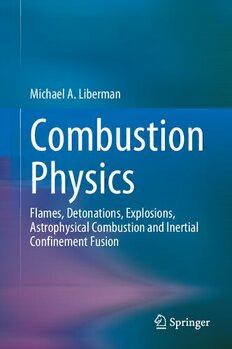
Combustion Physics: Flames, Detonations, Explosions, Astrophysical Combustion and Inertial Confinement Fusion PDF
Preview Combustion Physics: Flames, Detonations, Explosions, Astrophysical Combustion and Inertial Confinement Fusion
Michael A. Liberman Combustion Physics Flames, Detonations, Explosions, Astrophysical Combustion and Inertial Confinement Fusion Combustion Physics Michael A. Liberman Combustion Physics Flames, Detonations, Explosions, Astrophysical Combustion and Inertial Confinement Fusion MichaelA.Liberman NORDITA,KTHRoyalInstitute ofTechnology StockholmUniversity Stockholm,Sweden ISBN978-3-030-85138-5 ISBN978-3-030-85139-2 (eBook) https://doi.org/10.1007/978-3-030-85139-2 ©TheEditor(s)(ifapplicable)andTheAuthor(s),underexclusivelicensetoSpringerNature SwitzerlandAG2021 Thisworkissubjecttocopyright.AllrightsaresolelyandexclusivelylicensedbythePublisher,whether thewholeorpartofthematerialisconcerned,specificallytherightsoftranslation,reprinting,reuse ofillustrations,recitation,broadcasting,reproductiononmicrofilmsorinanyotherphysicalway,and transmissionorinformationstorageandretrieval,electronicadaptation,computersoftware,orbysimilar ordissimilarmethodologynowknownorhereafterdeveloped. Theuseofgeneraldescriptivenames,registerednames,trademarks,servicemarks,etc.inthispublication doesnotimply,evenintheabsenceofaspecificstatement,thatsuchnamesareexemptfromtherelevant protectivelawsandregulationsandthereforefreeforgeneraluse. Thepublisher,theauthorsandtheeditorsaresafetoassumethattheadviceandinformationinthisbook arebelievedtobetrueandaccurateatthedateofpublication.Neitherthepublishernortheauthorsor theeditorsgiveawarranty,expressedorimplied,withrespecttothematerialcontainedhereinorforany errorsoromissionsthatmayhavebeenmade.Thepublisherremainsneutralwithregardtojurisdictional claimsinpublishedmapsandinstitutionalaffiliations. ThisSpringerimprintispublishedbytheregisteredcompanySpringerNatureSwitzerlandAG Theregisteredcompanyaddressis:Gewerbestrasse11,6330Cham,Switzerland Preface In 1825, Michael Faraday initiated popular Christmas lectures in London, which remain the flagship scientific lectures in the U.K. until today. Eventually, Faraday presentedaseriesofsixlecturescenteredaroundflame,“TheChemicalHistoryof a Candle”,1 which proved to be hugely popular—and for a good reason: the quest forfireilluminatedhumanhistoryformillenniabutonlyatthetimeoftheIndustrial Revolutioncombustionemergedasadistinctareaofscience,settingouttoanalyze thechemicalprocessoffueloxidation.Inthepastonehundredandfiftyyears,this field experienced explosive growth alongside the appearance of the multitude of uses,fromcombustionenginestogasturbinestojetenginesandspacerockets!At last,combustionbecameascientificfieldduetothecombinedprogressinchemical kineticsandfluidmechanics.Itwaspossibletoexplainvariouscombustionmodes, such as flame, explosions, and detonation, which all make a strong impact on our lives. Today,combustionremainsatrulyinterdisciplinarysubject,andassuchitrequires mergingofvariousfieldsofscience,fromchemicalkineticsandthermodynamicsto fluidmechanics,nonlinearphenomena,andturbulence.Becauseofthiscomplexity, thein-depthscientificinvestigationofcombustionisarelativelyrecentphenomenon, despiteitslong-standingimpactonalltypesofhumanactivities. Delivering his lectures on The Chemical History of a Candle, Faraday justified hischoicebyclaimingthatthereisnobetter,thereisnomoreopendoorbywhich youcanenterintothestudyofsciencethanbyconsideringthephysicalphenomena ofacandle.Nowadays,combustionremainsafascinatingandfast-developingfield of physics. Faraday’s words about an open door by which you can enter into the studyofsciencecanbejustaswellappliedtocombustionphysics.Whileweoften hearpredictionsabouttheendofnewdiscoveriesinphysics,theactualendofnew discoveries never seems to come. The elements of combustion, such as a flame, explosion, and detonation, are known for a long time, but somewhat surprisingly 1TheChemicalHistoryofaCandle:ACourseofLecturesDeliveredBeforeAJuvenileAudience attheRoyalInstitutionbyMichaelFaraday,D.C.L.,F.R.S.EditedbyWilliamCrookes,F.C.S. CHATTOANDWINDUS,PUBLISHERS,London. v vi Preface their first principal description was obtained not such a long time ago and for a limitedrangeofconditions.Amorecoherentpictureemergedinrecenttimes,asa resultofmanyexperimentalandtheoreticalstudies,sponsoredbyenergyproduction andindustrialneeds. Combustionisaprocessofheatreleaseinexothermalreactions,whichisaccom- panied by mass and heat transfer. The chemical combustion involves a chemical transformationbetweenfuelsubstancesandoxidizers.Intheseprocesses,nucleiof theenteringsubstancesarenotalteredbutformednewmoleculesandatoms,which arecombustionproducts.Heatreleaseintheprocessofbondingismostinteresting sincethisenergycanbecapturedandusefullyexploited.Combustionmayinvolve allphasesofmatter—solid,liquid,andgas:solidrocketpropellants,liquiddroplets burningindiesels,andgaseouscombustioninSIengines.Theprincipaldifficultiesin understandingcombustionprocessesarethehugedifferencesoftimeandspacescales involved,chemicalcomplexity,andmultidimensionalnatureoftheflowconfigura- tion. In turbulent combustion, the strong nonlinear coupling of the turbulence and thechemistrybringadditionalcomplications.Chemicalreactions’ratesarecoupled tomoleculardiffusionatthesmallestscalesoftheturbulence.Furthermore,theheat releaseassociatedwithcombustionaffectstheturbulentflow,bothfromvariationsin themeandensityfieldandfromtheeffectsoflocaldilatation.Becauseofitsimpor- tance in many areas of physics and technology, combustion science is developing rapidlyandthereisanextensivevolumeofliteratureonthesubject.Afastprogress hasbeenachievedincombustionscienceduringalittlemorethan10yearssincethe publicationofmybook“IntroductiontoPhysicsandChemistryofCombustion”in 2008. Because of this progress, it was clear that a new book is necessary to bring readerstothefrontiersofthesubject. Combustionprocessessurroundusinoureverydaylives.Chemicalcombustionis usedforenergyproductioninpowerplants,gasturbines,andengines.Processesof thermonuclearcombustionaretheheatsourcefortheSunandstars.Aspecialinterest tothethermonuclearexplosionsoftypeIasupernovasisduetothepossibilitytouse theexplodingsupernovasascosmicstandardlightmarkerstoanalyzethefateofthe universeandtheuniversegeometry.UsingtypeIasupernovasasdistanceindicators led to the discovery of the accelerated expansion of the universe and changed our understandingoftheuniversegeometrytoanearlyflatuniversethatisexpandingat an accelerated rate. It was found that the universe expansion is speeding up rather thanslowingdown,whereaspreviouslyitwasthoughtthatgravityshouldslowdown theuniverseexpansion. Thisbookprovidesacomprehensivepresentationofstateoftheartofthecombus- tiontheory,focusingonthecombustionfundamentals.Thebookcontainsthemost recent scientific results in various fields related to combustion. In each chapter of thebook,andoneachissue,anexhaustivelistofreferencesontheoriginalresearch isprovided,includingthemostrecentpublications.Thepresentedmaterialisaimed at illustrating the physics of the phenomena under consideration and its quantita- tivedescriptionobtainedusinganalyticalmethodsandmultidimensionalcomputer modeling,aswellascomparisonwithexperimentalresults.Thelevelofthebookis Preface vii suitableforgraduateuniversitycoursesincombustionandforanadvancedcombus- tioncourse.Ingeneral,itwouldrequireasolidbackgroundinthermodynamicsand fluidmechanics,butItriedtopresentthematerialinawaysuitablefor2nd–3rdyears andPh.D.studentsofphysical,mathematical,chemical,andengineeringspecialties. Thelasttwochaptersofthebookdescribeapplicationsoftheoreticalmethodsdevel- opedincombustiontostudytypeIasupernovaexplosionsandstabilityproblemsin Inertial Confinement Fusion. Therefore, the book can be useful for astrophysicists andplasmaphysicists. I am indebted to many people who helped in the preparation of this book. ThisespeciallyappliestomycolleaguesatNordicInstituteofTheoreticalPhysics (NORDITA).Inparticular,IwanttothankAxelBrandenburgforcontinuedcollabora- tion;GregorySivashinskyforcarefullyreadingmanychaptersofthebookandgiving usefulcommentsonthebook’slayout;andtoChengengQianforhismeticuloushelp withpreparingtheillustrations. Uppsala,Sweden MichaelA.Liberman June2021 Contents 1 CombustionChemistry ........................................ 1 1.1 ChemicalReactions ...................................... 1 1.2 Non-branchingChainReaction:HydrogenChlorine ........... 10 1.3 FormationMechanismsofNitrogenOxides .................. 13 1.3.1 ThermalNOMechanism ........................... 14 1.3.2 PromptNOMechanism ............................ 18 1.3.3 FuelNO ......................................... 20 1.3.4 FlamesoftheFirst-OrderReaction .................. 21 1.4 Chain-BranchingReactions:Explosions ..................... 22 1.4.1 Hydrogen–OxygenExplosions:ExplosionLimits ..... 23 1.4.2 OxidationandExplosionsofHydrocarbons ........... 28 References .................................................... 30 2 Self-AcceleratingReactions .................................... 33 2.1 AOne-StepChemicalReactionModel ...................... 34 2.2 ElementaryTheoryofThermalExplosion ................... 35 2.3 ThermalSelf-Ignition ..................................... 38 2.4 Frank-KamenetskiiTransformation ......................... 42 2.5 SemenovTheoryofThermalExplosions ..................... 43 2.6 Frank-KamenetskiiTheoryofThermalExplosion ............. 46 2.7 SparkIgnitionandMinimumIgnitionEnergy ................ 49 2.8 InductionTime:One-StepandDetailedChemicalModels ...... 52 2.8.1 Hydrogen–Air: A Single-Step and Detailed ChemicalModels ................................. 53 2.8.2 Methane–Air: A Single-Step and Detailed ChemicalModels ................................. 54 References .................................................... 58 3 LaminarFlames .............................................. 61 3.1 ReactionWaves .......................................... 61 3.2 VelocityandThicknessofLaminarFlames ................... 65 3.3 TemperatureandConcentrationDistributions ................. 70 ix x Contents 3.4 Zel’dovich–Frank-KamentskiiTheory:LaminarFlame Speed ................................................... 75 3.5 ConsequencesoftheFormulaforNormalFlameVelocity ...... 79 3.6 LaminarNon-premixedFlames ............................. 80 3.6.1 Non-premixedLaminarFlames ..................... 81 3.6.2 CombustionofLiquidFuelDroplets ................. 83 References .................................................... 85 4 HydrodynamicsofPremixedLaminarFlames ................... 87 4.1 FlameHydrodynamics:CombustionRegimes ................ 87 4.2 CompleteSystemofEquationsforPropagatingFlame ......... 95 4.3 IsobaricApproximation ................................... 96 4.4 TheoryofPlanarFlames .................................. 98 References .................................................... 103 5 FlameInstabilities ............................................. 107 5.1 Darrieus-LandauInstabilityofZeroThicknessFlame .......... 107 5.2 HydrodynamicInstability;FlamesofFiniteThickness ......... 113 5.3 FlameinaGravitationalField;Rayleigh–TaylorInstability ..... 123 5.3.1 ComparisonwithNumericalSimulations ............. 125 5.4 Thermal-DiffusiveInstability .............................. 130 5.4.1 ThermalDiffusiveInstability(Le(cid:2)=1) ............... 131 5.4.2 ThermalDiffusiveInstabilityofSolidPropellant ...... 137 5.5 FlameDynamics;EvolutionEquation ....................... 141 5.5.1 EvolutionEquation;InfinitelyThinFlameFront ....... 141 5.5.2 EvolutionEquation;InfluenceofFiniteFlame Thickness ....................................... 144 5.5.3 EvolutionEquation;ArbitraryEquationofState ....... 148 5.5.4 InfluenceofCompressibility ........................ 153 References .................................................... 167 6 Flame–AcousticInteraction:ThermoacousticandParametric Instabilities ................................................... 171 6.1 Early Experimental Research on the Flame–Acoustic Interaction .............................................. 171 6.2 FlameStabilizationbyAcousticWaves ...................... 173 6.3 ParametricFlameInstabilityandSoundWaves ............... 177 6.4 ExperimentalStudyoftheDarrieus–LandauInstability ........ 182 6.5 Flame–AcousticInteraction:ThermoacousticInstabilities ...... 185 6.6 ApplicabilityofAnalyticalModels ......................... 187 References .................................................... 190 7 InteractionofFlameswithWeakShocks ........................ 193 7.1 LinearTheoryofFlame–ShockInteraction ................... 193 7.2 NonlinearEffectsofFlame–ShockInteractions ............... 201 7.3 Hydrodynamic Instability of Planar Flame in Closed Chambers ............................................... 211 Contents xi References .................................................... 216 8 DynamicsofCurvedFlamesPropagatinginTubes ............... 219 8.1 NonlinearStageofInstability;CellularFlame’sStructure ...... 219 8.2 NonlinearEquationforCurvedStationaryFlames ............. 224 8.3 Velocityof2DCurvedFlame .............................. 229 8.4 VelocityandShapeof2DFlame ............................ 232 References .................................................... 238 9 DynamicsofFlamesUnderConfinement ........................ 241 9.1 Hydrodynamic Instability of Planar Flame in Closed Chambers ............................................... 241 9.2 NumericalSimulationsoftheDLInstabilityinClosed Tubes ................................................... 246 9.2.1 FlamesoftheFirst-OrderReaction .................. 248 9.2.2 FlamesoftheThird-OrderReaction ................. 251 9.3 FlammabilityLimitsandFlameQuenching .................. 254 9.3.1 FlammabilityLimits .............................. 254 9.3.2 HeatLossesandFlameQuenching .................. 256 9.4 TulipFlames.EffectoftheBoundaryLayer .................. 259 9.4.1 Experimental,Theoretical,andNumericalStudies ..... 259 9.4.2 MechanismsoftheTulipFlameFormation ........... 263 9.4.3 NumericalSimulationsandMechanismofTulip FlameFormation ................................. 266 References .................................................... 274 10 FlameinaGravitationalField .................................. 279 10.1 TheRayleigh–TaylorInstability ............................ 279 10.2 VelocitiesofRisingBubbles ............................... 281 10.3 CurvedFlamesinVerticalTubes ........................... 282 10.4 FlameinHorizontalTubes ................................. 286 References .................................................... 289 11 StabilityLimits;SphericallyExpandingFlames .................. 293 11.1 FlameInstabilitiesinWideTubes ........................... 293 11.2 MorphologyofUnconfinedSphericallyExpandingFlames ..... 299 11.3 FractalStructureandSelf-similarRegime .................... 302 11.3.1 Fractal Dimension of 2D and 3D Expanding Flames .......................................... 302 11.3.2 StabilityofSelf-similarSphericallyExpanding Flames .......................................... 304 11.4 Self-acceleration and Fractal Structure of Expanding Flames .................................................. 310 References .................................................... 314
